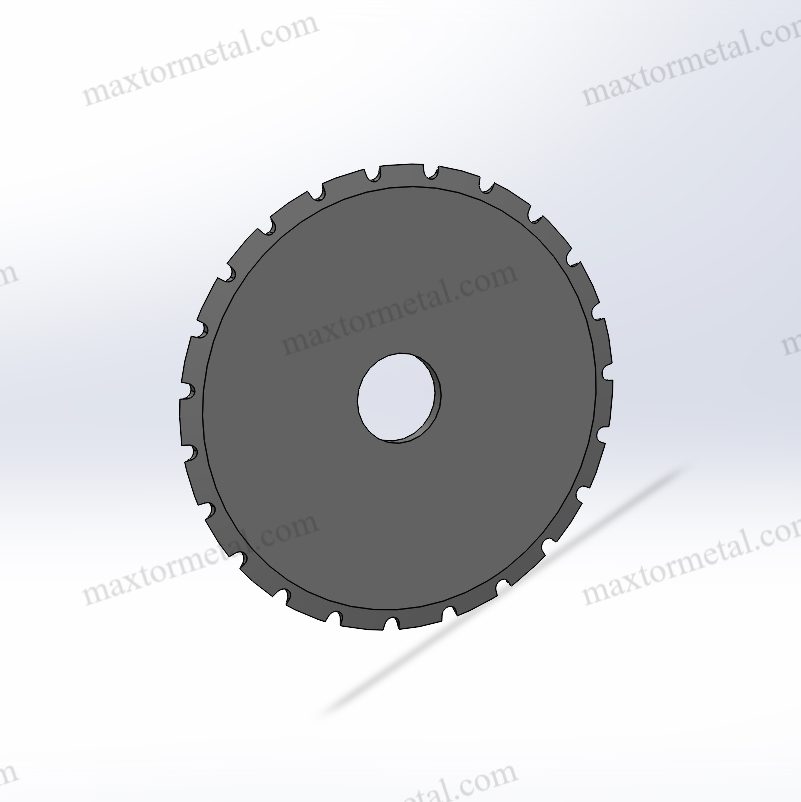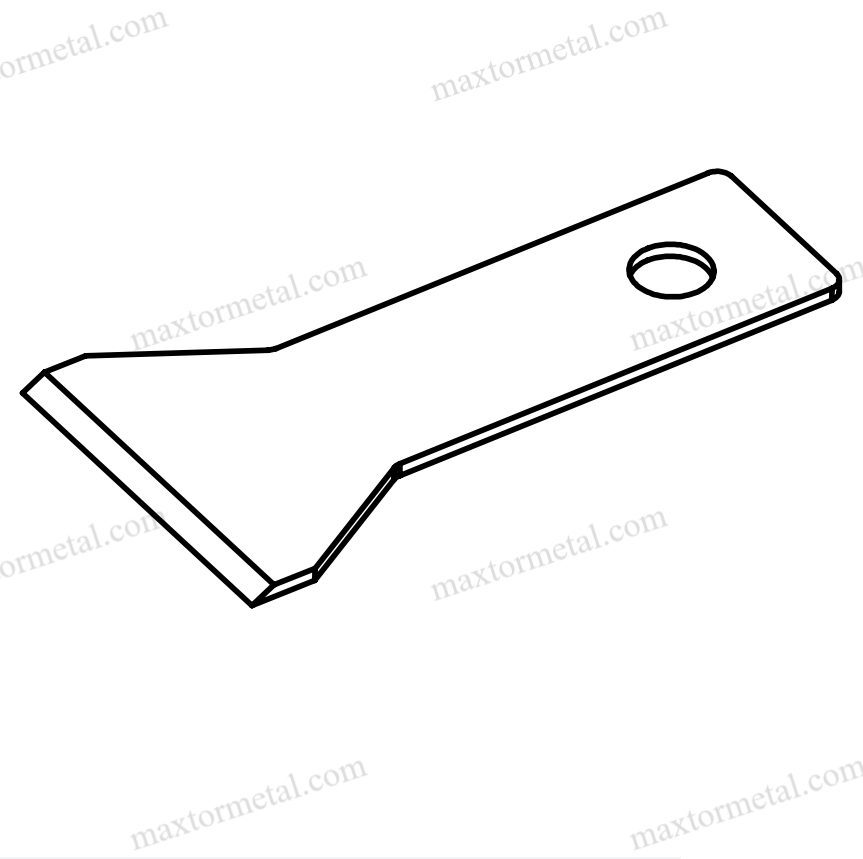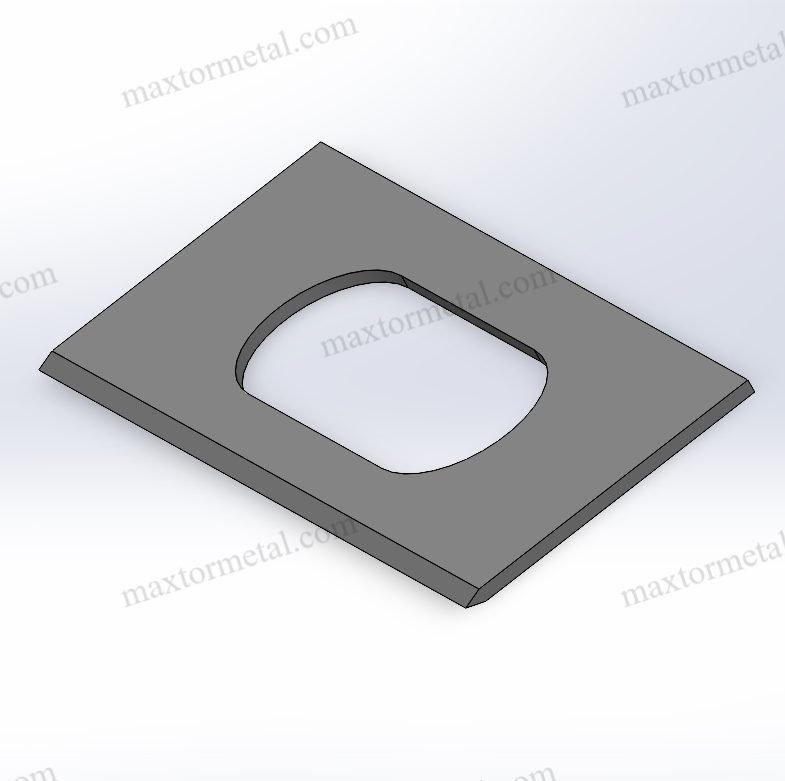Toleransi bilah industri memainkan peran penting dalam menentukan efisiensi, daya tahan, dan efektivitas biaya dari proses produksi. Memilih toleransi yang salah dapat menyebabkan kinerja pemotongan yang buruk, keausan mesin yang berlebihan, dan peningkatan biaya operasional. Studi menunjukkan bahwa toleransi bilah yang tidak tepat dapat mengakibatkan biaya perawatan yang lebih tinggi hingga 30% karena ketidaksejajaran dan peningkatan tingkat keausan.
Pada Nanjing Metal, kami memiliki 18 tahun pengalaman dalam mendesain dan memproduksi pisau industri presisiKeahlian kami memungkinkan kami untuk menawarkan pisau industri khusus yang menyeimbangkan standar toleransi bilah dengan efisiensi biaya. Dalam artikel ini, kita akan membahas dasar-dasar toleransi bilah industri, dampaknya terhadap kinerja dan produksi, serta cara memilih toleransi optimal untuk berbagai aplikasi.

1. Apa itu Toleransi Pisau Industri?
Definisi Toleransi Blade
Toleransi bilah industri mengacu pada rentang variasi dimensi bilah yang dapat diterima, termasuk ketebalan, panjang, lebar, dan ketajaman tepi. Toleransi ini memastikan bahwa spesifikasi bilah mesin memenuhi persyaratan operasional tanpa mengorbankan kinerja.
Peran Toleransi dalam Kinerja Blade
Toleransi pembuatan bilah yang ditentukan dengan baik memastikan bahwa:
- Pisau terpasang secara presisi pada mesin pemotong, mencegah ketidakselarasan dan mengurangi getaran.
- Proses pemotongan tetap konsisten, mengurangi risiko cacat material.
- Waktu henti produksi diminimalkan karena lebih sedikit penyesuaian dan penggantian.
Kisaran Toleransi Blade Umum
Industri yang berbeda memerlukan tingkat presisi yang berbeda. Berikut adalah panduan umum untuk standar toleransi bilah:
| Jenis Pisau | Toleransi Ketebalan (mm) | Toleransi Panjang (mm) | Toleransi Tepi (mm) |
| Standar Industri | ±0,05 detik | ±0,10 | ±0,02 |
| Pemotongan Presisi | ±0,02 | ±0,05 detik | ±0,01 |
| Medis/Dirgantara | ±0,01 | ±0,03 detik | ±0,005 detik |
Memilih toleransi yang tepat sangat penting untuk menyeimbangkan kinerja bilah dan efisiensi produksi.
2. Mengapa Memilih Toleransi Mata Pisau yang Tepat Itu Penting
Dampak Toleransi Ketat vs. Toleransi Longgar
Banyak produsen berasumsi bahwa toleransi bilah yang lebih ketat selalu menghasilkan kinerja yang lebih baik. Meskipun presisi tinggi sangat penting dalam beberapa aplikasi, toleransi yang terlalu ketat dapat meningkatkan biaya produksi tanpa memberikan manfaat yang substansial. Di sisi lain, toleransi yang longgar dapat menyebabkan inkonsistensi kinerja dan ketidaksejajaran bilah mesin. Mencapai keseimbangan yang tepat adalah kuncinya.
Toleransi yang Lebih Ketat: Kapan Itu Membantu?
Toleransi yang lebih ketat (misalnya, ±0,01 mm) sangat penting ketika:
- Pisau harus berinteraksi dengan komponen presisi lainnya (misalnya pisau bedah dan pisau luar angkasa).
- Proses pemotongan berkecepatan tinggi menuntut konsistensi, seperti pada pencetakan logam presisi tinggi.
- Bahan yang dipotong sangat sensitif (misalnya, film ultra-tipis atau komposit halus).
Namun, untuk mencapai toleransi yang sangat ketat memerlukan penggilingan CNC tingkat lanjut, pengukuran laser, dan langkah-langkah kontrol kualitas tambahan, yang semuanya meningkatkan biaya.
Toleransi yang Lebih Longgar: Kapan Toleransi Dapat Diterima?
Toleransi bilah yang lebih longgar (misalnya, ±0,05 mm atau ±0,10 mm) dapat diterima ketika:
- Proses pemotongan tidak menuntut ketelitian yang tinggi (misalnya, pengerjaan kayu, pengirisan makanan dalam jumlah besar).
- Mesin memungkinkan sedikit variasi tanpa memengaruhi kinerja.
- Sifat material kurang terpengaruh oleh variasi toleransi (misalnya, kardus, karet, plastik).
Dengan memilih toleransi yang sesuai daripada toleransi yang terlalu ketat, bisnis dapat mengurangi biaya produksi hingga 20-30% sambil mempertahankan kinerja pemotongan yang efektif.
Studi Kasus: Pisau Pengolahan Makanan
Sebuah perusahaan pengemasan makanan awalnya menetapkan toleransi ±0,01 mm untuk bilah pemotongnya, dengan asumsi hal itu akan meningkatkan akurasi pemotongan. Namun, kenyataannya adalah:
- Biaya produksi meningkat sebesar 30%, karena toleransi yang lebih ketat memerlukan pemesinan presisi yang canggih.
- Waktu tunggu menjadi dua kali lipat karena adanya kontrol kualitas dan proses kalibrasi tambahan.
- Peningkatan kinerja minimal, dengan toleransi ±0,02 mm, memberikan konsistensi pemotongan yang sama.
Setelah menilai ulang persyaratan mereka, mereka melonggarkan toleransi menjadi ±0,02 mm, dan memperoleh:
✅ Penghematan biaya 20% pada produksi bilah
✅ Waktu produksi lebih cepat, mengurangi waktu tunggu hingga 40%
✅ Tidak ada penurunan kinerja yang nyata
Ini menunjukkan bagaimana toleransi yang terlalu ketat dapat menjadi beban keuangan yang tidak perlu.
Kompatibilitas Peralatan dan Kinerja Blade
Interaksi antara toleransi bilah dan spesifikasi bilah mesin sangat penting:
- Apabila toleransi terlalu longgar, bilah mungkin tidak sejajar, mengakibatkan pemotongan yang buruk dan peningkatan keausan pada mesin.
- Jika toleransi terlalu ketat, penundaan produksi dan biaya yang lebih tinggi dapat terjadi karena persyaratan presisi yang berlebihan.
- Menemukan toleransi pembuatan bilah yang optimal menjamin kompatibilitas mesin dan operasi yang hemat biaya.

3. Bagaimana Toleransi Bilah Terkait dengan Proses Manufaktur
Pentingnya Mencocokkan Toleransi dengan Presisi Manufaktur
Pemilihan toleransi bilah yang tepat memerlukan pemahaman tentang seluruh ekosistem manufaktur. Bahkan pisau industri yang paling presisi pun tidak dapat mengimbangi ketidakakuratan pada komponen mesin lainnya.
Misalnya, jika mesin memiliki akurasi posisi ±0,05mm, menggunakan bilah dengan Toleransi ±0,01mm tidak memberikan manfaat tambahan—hanya meningkatkan biaya produksi.
| Presisi Mesin | Toleransi Blade yang Direkomendasikan | Alasan |
| ±0,10 mm | ±0,05 mm | Tidak perlu presisi yang ekstrim |
| ±0,05 mm | ±0,02 mm | Menyeimbangkan kinerja & biaya |
| ±0,02 mm | ±0,01 mm | Diperlukan untuk pekerjaan presisi |
Poin utama: Toleransi bilah harus selaras dengan presisi seluruh sistem, bukan hanya bilahnya saja.
Dampak Toleransi Blade terhadap Efisiensi Produksi
Toleransi bilah secara langsung mempengaruhi efisiensi dan efektivitas biaya manufaktur:
- Toleransi yang lebih ketat memerlukan pemesinan tingkat lanjut, seperti penggilingan CNC, pemotongan EDM, atau pengukuran laser, sehingga meningkatkan biaya.
- Toleransi yang lebih longgar memungkinkan produksi yang lebih cepat, mengurangi waktu tunggu produksi hingga 50%.
- Spesifikasi toleransi bilah yang terlalu tinggi akan menyebabkan pemborosan material dan meningkatkan biaya keseluruhan.
Contoh: Analisis Biaya Toleransi Blade
| Tingkat Toleransi | Peningkatan Biaya Produksi | Peningkatan Waktu Tunggu | Sampah Material |
| ±0,10 mm | Biaya dasar | Standar | Minimal |
| ±0,05 mm | +10% biaya | +15% waktu | Sedang |
| ±0,01 mm | biaya +40% | +50% waktu | Tinggi |
Seperti ditunjukkan di atas, pengetatan toleransi melampaui apa yang diperlukan menyebabkan biaya yang lebih tinggi tanpa peningkatan fungsional yang signifikan.
Pertukaran antara Presisi dan Biaya
Untuk menghindari biaya yang tidak perlu, produsen harus:
- Menilai keakuratan mesin sebelum menentukan toleransi bilah.
- Prioritaskan fungsionalitas daripada presisi ekstrem kecuali diperlukan untuk aplikasi khusus.
- Konsultasikan dengan produsen pisau untuk menentukan keseimbangan terbaik antara biaya dan kinerja.
4. Mengevaluasi Persyaratan Toleransi Khusus Aplikasi
Standar Toleransi Bilah Khusus Industri
Toleransi bilah industri yang sesuai bervariasi menurut industri. Berikut ini adalah persyaratan toleransi yang umum:
| Industri | Toleransi yang Direkomendasikan | Mengapa Hal Ini Penting |
| Industri Medis | ±0,01 mm | Memastikan ketepatan dan keamanan bedah |
| Ruang angkasa | ±0,02 mm | Menjaga integritas struktural |
| Kemasan | ±0,05 mm | Memungkinkan pemrosesan kecepatan tinggi |
| Pengerjaan kayu | ±0,10 mm | Memberikan fleksibilitas untuk variasi material |
Kapan Menggunakan Toleransi yang Lebih Ketat
✅ Aplikasi presisi tinggi di mana penyimpangan sekecil apa pun dapat menyebabkan cacat:
- Pisau bedah medis & pisau bedah (di mana presisi memengaruhi keselamatan pasien).
- Perkakas pemotong kedirgantaraan (di mana integritas struktural sangat penting).
- Pisau pemotong mikroelektronika & semikonduktor (di mana ketidakselarasan kecil memengaruhi hasil produksi).
Ketika Toleransi Standar Cukup
✅ Aplikasi manufaktur umum di mana variasi kecil tidak memengaruhi kinerja:
- Pisau Kemasan (±0,05mm biasanya cukup untuk pemotongan yang bersih).
- Pisau pemotong makanan (di mana ±0,02mm dapat mempertahankan efisiensi tanpa biaya tambahan).
- Pisau pemotong kayu (±0,10mm sering kali dapat diterima karena kayu memiliki ketidakteraturan alami).
Cara Menentukan Toleransi yang Tepat untuk Aplikasi Anda
Untuk memilih toleransi bilah yang optimal, pertimbangkan:
- Sifat material (material lunak seperti plastik menoleransi toleransi yang lebih longgar).
- Cutting speed requirements (high-speed cutting may require tighter tolerances).
- Machine precision (if the machine’s accuracy is low, ultra-precise blades won’t improve performance).
- Cost-benefit analysis (is the added precision worth the expense?).
Practical Example: Packaging Industry
A packaging company originally used ±0.02mm tolerances for their cutting blades, assuming it would improve edge precision. However, testing showed that ±0.05mm produced the same results while:
- Reducing blade costs by 25%
- Lowering production waste by 15%
- Decreasing lead times by 35%
This example highlights why evaluating application needs before setting tolerance levels is crucial.

5. Implikasi Biaya dari Toleransi yang Terlalu Ketat
Choosing an unnecessarily tight industrial blade tolerance can lead to higher manufacturing costs, increased material waste, and longer production lead times. While many manufacturers assume that tighter tolerances always yield better performance, the reality is that diminishing returns often set in. Understanding these cost factors can help businesses optimize their machinery blade specifications for better efficiency and profitability.
Higher Manufacturing Costs Due to Over-Specification
The cost of producing pisau industri presisi increases exponentially as tolerances become stricter. This is because tighter tolerances require:
- High-Precision Equipment
- Advanced CNC grinding, EDM (Electrical Discharge Machining), and laser cutting are needed to achieve sub-micron accuracy.
- These machines operate at slower speeds to maintain accuracy, reducing overall productivity.
- Extended Quality Control Processes
- Every batch of industrial knives must undergo more rigorous inspections, including:
- Laser scanning for dimensional accuracy
- Surface roughness measurements
- Edge sharpness consistency checks
- This increases labor costs and slows down delivery times.
- Every batch of industrial knives must undergo more rigorous inspections, including:
- Specialized Manufacturing Environments
- Temperature and humidity-controlled facilities are needed for ultra-tight tolerances (e.g., ±0.005mm).
- Even minor environmental variations can impact the final product, requiring additional process adjustments.
Example: Cost Increase for Tighter Tolerances
| Tingkat Toleransi | Peningkatan Biaya Produksi | Production Speed Reduction |
| ±0,10 mm | Baseline cost | Standard speed |
| ±0,05 mm | +15% cost | -10% speed |
| ±0,02 mm | biaya +40% | -25% speed |
| ±0,01 mm | +75% cost | -50% speed |
From the table, we see that moving from a ±0.10mm tolerance to a ±0.01mm tolerance can increase costs by up to 75% while halving production speed. Manufacturers should carefully evaluate whether such precision is truly necessary.
Material Waste and Its Financial Impact
Tighter tolerances result in higher rejection rates. Even small deviations can cause entire batches to be discarded, increasing raw material costs and waste disposal fees.
- A ±0.01mm tolerance may require 5-10% of blades to be scrapped due to slight imperfections.
- A ±0.05mm tolerance can reduce scrap rates to below 2%, leading to significant cost savings.
Case Study: Aerospace Blade Manufacturing
An aerospace parts manufacturer initially required ±0.005mm tolerance for turbine cutting blades. However, after analyzing performance data, they found that ±0.02mm offered the same functionality. This adjustment:
✅ Reduced material waste by 35%
✅ Saved $500,000 annually in rejected blades
✅ Shortened production cycles by 20%
The Diminishing Returns of Ultra-Tight Tolerances
Beyond a certain point, tightening tolerances does not improve performance. For example:
- A ±0.02mm tolerance often performs just as well as a ±0.01mm tolerance in industrial cutting applications.
- Over-tightening tolerances does not extend blade lifespan unless machine components are also equally precise.
- Tolerances below ±0.01mm are often only necessary for specialized applications, such as semiconductor cutting or medical scalpels.
Instead of over-specifying tolerance, manufacturers can focus on blade coatings, material selection, and edge geometry to achieve superior cutting performance.
Extended Lead Times and Supply Chain Delays
- Strict tolerances require additional machining time, slowing down overall production.
- Tighter tolerances mean fewer suppliers can meet the requirements, increasing procurement risks.
- More frequent recalibrations and rework cause unexpected delays and production bottlenecks.
For high-volume industries such as food processing, packaging, and metal stamping, unnecessarily tight tolerances can double production times and delay order fulfillment.

6. Bagaimana Konsultasi Ahli Dapat Membantu Mengoptimalkan Toleransi Blade
At Nanjing Metal, we:
- Assess customer requirements to determine optimal blade tolerance standards.
- Provide pisau industri khusus designed for specific cutting applications.
- Offer alternative solutions, such as pelapis bilah dan material upgrades, to enhance performance without increasing tolerance requirements.
7. Manfaat Memilih Toleransi Mata Pisau yang Tepat
Optimizing industrial blade tolerance provides multiple long-term advantages:
1. Lower Production Costs
- Avoid unnecessary precision expenses.
- Reduce raw material waste by minimizing rejected blades.
- Simplify quality control and inspection processes.
2. Faster Lead Times
- Simpler machining processes reduce production delays.
- Less stringent quality control speeds up blade delivery.
- Broader supplier availability ensures reliable sourcing.
3. Consistent Blade Performance
- Balanced tolerances help maintain machine compatibility and cutting stability.
- Avoids excessive friction and premature blade wear.
- Supports reliable production cycles in high-speed environments.
4. Sustainable Manufacturing Practices
- Reduces material waste by selecting realistic tolerance limits.
- Lowers energy consumption by reducing excessive grinding and polishing.
- Supports lean manufacturing principles by eliminating unnecessary precision steps.

Choosing the right industrial blade tolerance is not just about precision—it’s about balancing cost, efficiency, and performance. Overly tight tolerances increase expenses without necessarily improving blade functionality.
Pada Nanjing Metal, we help clients analyze their needs, optimize tolerances, and find cost-effective solutions. Our team can assist with pisau industri khusus, material upgrades, and manufacturing consultations.
📩 Hubungi kami hari ini to optimize your blade tolerance standards and improve your production efficiency!
Referensi
- Manufacturing cost data sourced from The International Journal of Advanced Manufacturing Technology (2023).
- Performance impact of tolerances from The American Society of Mechanical Engineers (ASME) Reports.
- Industry-specific tolerance standards from ISO 2768 and ANSI B4.1.


